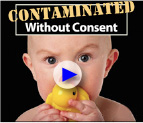The Workgroup for Safe Markets has developed these Five Essential Practices for Retailers, Brand Owners and Suppliers (see below), and a detailed Background Paper, to clarify our goals for the business community. The Practices have been featured on Triple Pundit.
These Five Essential Practices will guide the transition to safer chemicals and materials through increased disclosure of chemical information and informed substitution practices.
Five Essential Practices for Retailers, Brand Owners and Suppliers
Transitioning to Safer Chemicals and Materials Through Increased Disclosure of Chemical Information and Informed Substitution of Hazardous Chemicals
Government mandates, consumer demand, and pressure from public health advocates are increasingly pushing brand owners, retailers and suppliers to identify and eliminate hazardous chemicals and materials in the products they make and sell. Companies that phase out hazardous chemicals position themselves as innovators and consumer-friendly, while reducing reputational and financial liabilities and reporting requirements. Unfortunately, substitutes for phased out chemicals are far too often not disclosed, and substitutes for hazardous chemicals have often not been comprehensively screened for health and environmental hazards. These failures diminish the public’s faith that reformulated products are actually safer, and leave companies exposed to new liabilities and new government or consumer demands.
These Five Essential Practices will ensure that brand owners, suppliers, and retailers transition away from hazardous chemicals of concern by ensuring that any substitutes have been fully screened for health and environmental hazards and disclosed to consumers and governments:
1. Retailers, brand owners and suppliers will establish a goal of reducing and eliminating the use of chemicals and materials of concern1 in products and manufacturing processes, and replacing them with alternatives that are transparently safer. Their publicly available chemicals management plans will include metrics and clear timeframes to measure continual progress towards this goal. As a priority, retailers and brand owners will identify relevant chemicals of high concern in products and supply chains, volume of those chemicals, and set goals for reducing both the number and volume of these chemicals.
2. Retailers and brand owners will know and publicly disclose the chemical ingredients in their products, product packaging and manufacturing processes. They will do this by requiring their suppliers to give full chemical disclosure including of fragrances, additives, contaminants, raw materials, colorants, flavorings and chemical by-products and they will make this information publicly available online and/or on product packaging. A good first step is to disclose all chemicals of high concern in products including those under proprietary agreements.
3. Retailers, brand owners and suppliers will identify chemicals and materials in their products and/or supply chains for chemicals of concern for substitution with safer alternatives that have undergone comprehensive hazard screening. The hazard profile of a chemical will be determined using comprehensive human health and environmental endpoints and all data gaps for chemical information will be clearly stated.
4. Retailers, brand owners and suppliers will conduct or require alternatives assessment for chemicals of concern as set out in the Business-NGO Principles of Alternatives Assessment. Alternatives will include a wide range of options ranging from simple elimination to informed substitution for safer chemical, material and non-chemical alternatives
5. Retailers, brand owners and suppliers will commit to continuous improvement in eliminating all chemicals and materials of concern in their supply chain and will support innovation and public policies that promote green chemistry, sustainable product design and manufacturing processes that protect human health and the environment. Retailers, brand owners and suppliers will publicly report on their progress in transitioning to safer chemicals and materials on their websites and in their shareholder reports.
A comprehensive description of the Five Essential Practices, including methods, measures, and tools, is available here.
These Practices were developed jointly by partners in the Workgroup for Safe Markets (which is coordinated by the environmental health and justice collaborative Coming Clean) including: Breast Cancer Fund, Center for Food Safety, Center for Environmental Health, Clean and Healthy New York, Clean Production Action, Commonweal, Healthy Building Network, International Campaign for Responsible Technology, Learning Disabilities Association of Maine, Natural Resources Defense Council, Safe Minds, Safer Chemicals Healthy Families, and Women’s Voices for the Earth.
References:
1 - Examples of priority chemical lists for brand owners and retailers include the Hazardous 100+ list created by the Mind the Store campaign (http://saferchemicals.org/chemicals/) and the SIN list created by ChemSec (http://sinlist.org).




